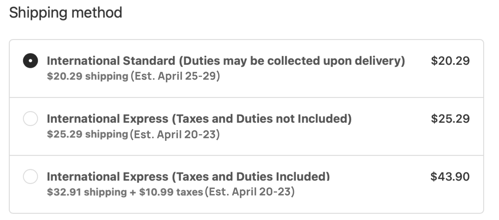Cold Chain Logistics: Management Challenges & Solutions
The supply chain is a term used to describe all the components required to transport goods from beginning to end, from production to the end...

As the eCommerce space grows every year, more and more companies based in the US expand globally. Shipping internationally can be tricky but with the right planning, study and execution it can greatly increase your brands revenue. By not selling to a global audience you could be missing out on a substantial amount of sales. And as each country differs in economic standing it is extremely beneficial to diversify the markets you are selling to. These are some of the many incredible benefits to shipping internationally.
In this guide to begin your international journey you will learn how and when it is best to start shipping globally. How to market to an international audience. How to maintain legal tax compliance. And which carriers offer international shipping rates.
Over the last few years the number of eCommerce sales worldwide has grown and will continue to grow. By expanding to the global market your brand has a chance to capture some of this growth.
How to know when to start shipping internationally?
Many eCommerce brands are scared to start shipping internationally. It can be complicated and costly. But, it doesn't have to be like that. BUKU offers several solutions to help ease your journey to gain marketshare in the international markets.
Use your social media and website analytics to gauge how many international followers you already have. By using these insights you can see if there is potential for a global expansion.
Another way to start shipping internationally is evaluating your domestic sales. If you are successful domestically it might be smart to test in a similar market. Canada or the UK are great markets to first test if your product will succeed internationally.
Take it one step at a time always monitoring your progress and reevaluating when roadblocks are placed before the brand. Shipping internationally doesn't have to be unobtainable. With hard work and great partners your brand can start shipping globally in no time.
How to know where to ship?
When first starting out you need to make the decision as to which countries you are going to ship to. This is a very important decision for your brand. One way to narrow your search down by is looking at your website analytics.
Website analytics are able to show you the location of those visiting your site. Looking at this information you're able to see which countries would be best to target. If you're getting more website hits from the UK that should be your first international destination to focus on.
What are some of the best countries to ship to?
A Shopify article "Global Ecommerce: Stats and Trends" breaks down top locations eCommerce brands can focus their efforts. Which countries have seen large growth and which ones are doing the most sales online. Here are some of the facts:

This demonstrates how large the possibilities are. Not just for EU or UK but other countries as well. China is of course leading the global marketing in e commerce sales. They account for "46.3% of all retail eCommerce sales worldwide."
Go where you feel your brand has a good fit. Spreading yourself too thin, especially at the beginning will cause the process to be more complex and additional problems can arise. By focusing your effort on one or a few countries to ship you can avoid these issues.
Above is an insightful graph showing how each country differs from each other in eCommerce sales. Each country has its challenges but shipping to a country that already has established eCommerce sales makes it more simple for your brand to join in and take some of the market share.
How can I market internationally?
Marketing to an international audience used to be difficult. But since the advent and spread of social media this is easier than ever. Social media is a great way to get your brand recognized globally. Not only does social media spread your brand internationally but it also can connect them directly to your store. This eliminates friction and gives customers quick access to a purchase.
Every social media platform offers something different for your brand. You're able to pick and choose which ones work best for your brand and focus your efforts on them.
Some of the most popular social media platforms include:
Long form: YouTube
YouTube is a longer form video platform. Many influencers, brands and businesses use YouTube to build their reputation, give in depth looks at the brand, and much more. Some of the largest Shopify brands are built from YouTube. Mr. Beast, Dude Perfect, Mark Rober, Emma Chamberlain, and thousands more have successful Shopify stores shipping all around the world.
As a brand there are endless possibilities of how to use YouTube to get your brand out there! Some clothing brands sponsor influencers to get them to promote their product. This is a great way to reach a younger audience and seem professional at the same time. Doing brand deals on YouTube can also carry over to Instagram or Twitter in the same deal. Chose who you work with carefully. If you have the marketing budget, brand deals are a great way to get your name out there.
Another way to use YouTube is by showcasing your brand through long form video. Whether this is by showing a behind the scenes of creating the product, a how to video, or highlighting your brands overall mission. The possibilities are endless.
Short form: Instagram, Twitter, TikTok and Facebook
Instagram, Facebook, Twitter and TikTok are great platforms to showcase your products and create a brand image.You can also linking directly to your products and store in posts and in your biography.
Over the last few years social media purchases have grown exponentially. 98% of consumers plan to make a purchase on social media in 2022 according to SproutSocial. Social media is going to be a huge contender this year and in the years to come. Doing business on social media will become vital and gives you the opportunity to drive demand through the roof.
There are two ways to go about spreading awareness for your brand for these social platforms. The first is starting your own accounts on each. Posting often and with purpose lets the consumers see that you are a legit brand and can be trusted. They also can see your products on display and follow for deals, new products, etc.
Once you start posting regularly on each platform you have the opportunity to do brand deals. Tons of "influencers" with hundreds to millions of followers can help get your brand and message globally. If you're looking to start shipping to Spain, look for a popular Spanish social media content creator to work with. This is a great way to enter new markets and get your brand visible to new customers.
International Tax support
Maintaining tax compliance when shipping internationally can be complicated. This is where BUKU can help you. Our international software solution allows you to focus on growing your brand instead of worrying about International taxes and duties.
Our solutions include:
Calculation and collection of taxes and duties
With IntelliRate, our Shopify app, you're able to automatically calculate all taxes and duties necessary for your international shipment in the checkout. It then displays it in the cart for the customer to see. This increases transparency and trust between the brand and its customers.
When shipping internationally you must pay taxes and duties in order for your product to comply with the laws of the country it's entering. Without making these payments it can get held up at customs or force the customer to pay when delivered.
Once the taxes and duties are calculated they are added to the final shipping cost so that you can collect and pay the correct amount.
This also allows you to offer DDU(Delivered Duty Unpaid) and DDP(Delivered Duty Paid) options.

This shopping cart is easy to read, understandable for international customer and gives them the power of choice. Not to mention that it also gives them an option for express shipping instead of only have the standard option.
IOSS Number
In order to ship to the EU you need to have access to an IOSS (Import One Stop Shop) number. Luckily BUKU has an available IOSS number for all users to access when shipping overseas.
Gaining your own IOSS number as a brand is a lengthy and expensive process. Working with BUKU saves you precious time and funds.
Tax Filing
Filing European taxes can be complicated and time consuming. When first starting to ship internationally taxes can be a daunting task to overcome.
BUKU's European subsidiary works with all of our brands to provide them EU tax filing. Focus on growing your brand instead of worrying about international tax compliance. Our services take care of all your tax needs.
How can carriers help brands ship internationally?
There are many carriers that offer amazing international rates for eCommerce brands. UPS, FedEx, DHL and USPS just to name a few are great carriers that offer great rates. Another shipping company that has been doing great parcel deliveries internationally is Landmark Global. They are the leading carrier into Canada and offer amazing rates for brands looking to ship domestically and internationally as well.

Do your due diligence as a brand to find which carrier works best for your needs. The best rates vary depending on what you are shipping and where it is being shipped to and from.
Final Thoughts
Shipping internationally can seem daunting. As an eCommerce brand there are certain steps to take to make the process easier.
Every brand is unique. There is no perfect step by step guide to perfectly expand your business globally. That is why BUKU is here. To give all eCommerce brands the potential for international success.
Want to speak to a shipping expert about your eCommerce goals and plans? Click the button below to schedule a time! We're happy to help!

The supply chain is a term used to describe all the components required to transport goods from beginning to end, from production to the end...

A smart warehouse is a large building where raw materials and other consumer goods are stored using machines, computers, comprehensive software, and...

Direct-to-consumer (DTC) fulfillment is a strategy that helps brands sell and deliver their products directly to customers more efficiently while...